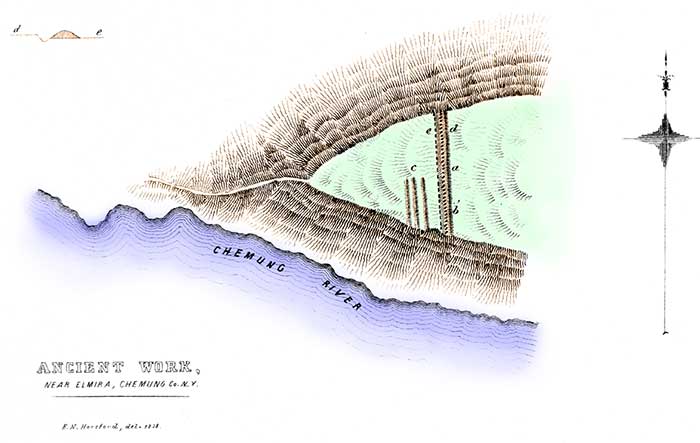CHEMUNG COUNTY.
THERE is a work in this county which possesses peculiar interest, from the circumstance that the embankments still retain unmistakable traces of the palisades with which it was crowned, thus demonstrating the correctness of the conjectures already indulged in, as to the probable construction of the entire system of earthworks of Western New York. The accompanying plan and description are from the note-books of Prof E. N. Horsford, of Harvard University, who visited this work in company with other gentlemen connected with the State Geological Survey, at the time that enterprise was in progress.

PLATE VI. No. I.
ANCIENT WORK NEAR ELMIRA, CHEMUNG COUNTY, NEW YORK.
"This work is situated about two and a half miles west of Elmira, upon the summit of an eminence, the base of which, upon one side, is washed by Chemung River, and upon the other by the waters of a deep and almost impassable ravine. It is, in fact, a bold headland. The approach is by a narrow path, which in some places will admit of the passage of a single person only, and which traverses the very abrupt crown of the ridge. Towards the top, the ascent is more gradual, and the ground continues to ascend slightly until we reach the defences. The site chosen exhibits the strongest proof of design, being such as to command a most extensive view along the course of the river, and being, except from behind, accessible only by the difficult pathway already mentioned.
"The artificial defences consist of an embankment, with an outer ditch, which extends, as shown in the plan, from the steep bank towards the river, to the brow of the ravine upon the other side. This embankment is about two hundred feet long, fourteen feet broad at the base, and about three and a half feet high. The rotting stump of an old pine-tree, three feet in diameter, and a yellow pine-tree, nine feet in circumference, are standing upon the wall, and indicate its high antiquity.
"What appeared to be a furrow was observed extending along the summit of the embankment throughout its entire length. Upon examination, it was found that this appearance was produced by a succession of holes, about a foot in depth. Just within this chain of holes is another parallel chain, not quite so distinct as the first. Still further inwards, and extending but part of the way across the area of the work, are several parallel furrows, without accompanying ridges, the design of which is hardly apparent."
It will be seen that this work corresponds entirely in position with most of the earth-works of the State, was chosen with reference to the same principles, and was defended in precisely the same manner. It is peculiar in still retaining the holes left by the decay of the palisades, which show that it was strengthened by a double line. It is rational to conclude, upon general principles, that all the works of the State were protected in like manner; although, except in this instance, all traces of the wooden superstructure have disappeared. As already observed, this work, for the positive light which it throws upon the original character of these ancient defences, is probably the most interesting one in the State.

